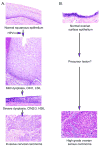Antigen-specific immunotherapy of cervical and ovarian cancer
- PMID: 18363994
- PMCID: PMC2692865
- DOI: 10.1111/j.1600-065X.2008.00622.x
Antigen-specific immunotherapy of cervical and ovarian cancer
Abstract
We contrast the efforts to treat ovarian cancer and cervical cancer through vaccination because of their different pathobiology. A plethora of approaches have been developed for therapeutic vaccination against cancer, many of which target defined tumor-associated antigens (TAAs). Persistent infection with oncogenic human papillomavirus (HPV) types causes cervical cancer. Furthermore, cervical cancer patients frequently mount both humoral and T-cell immune responses to the HPV E6 and E7 oncoproteins, whose expression is required for the transformed phenotype. Numerous vaccine studies target these viral TAAs, including recent trials that may enhance clearance of pre-malignant disease. By contrast, little is known about the etiology of epithelial ovarian cancer. Although it is clear that p53 mutation or loss is a critical early event in the development of epithelial ovarian cancer, no precursor lesion has been described for the most common serous histotype, and even the location of its origin is debated. These issues have complicated the selection of appropriate ovarian TAAs and the design of vaccines. Here we focus on mesothelin as a promising ovarian TAA, because it is overexpressed and immunogenic at high frequency in patients, is displayed on the cell surface, and potentially contributes to ovarian cancer biology.
Figures

References
-
- Parkin DM, Bray F, Ferlay J, Pisani P. Global cancer statistics, 2002. CA Cancer J Clin. 2005;55:74–108. - PubMed
-
- zur Hausen H. Papillomaviruses and cancer: from basic studies to clinical application. Nature Rev Cancer. 2002;2:342–350. - PubMed
-
- Schiffman MH, et al. Epidemiologic evidence showing that human papillomavirus infection causes most cervical intraepithelial neoplasia [see comments] J Natl Cancer Inst. 1993;85:958–964. - PubMed
-
- Walboomers JM, et al. Human papillomavirus is a necessary cause of invasive cervical cancer worldwide. J Pathol. 1999;189:12–19. - PubMed
Publication types
MeSH terms
Substances
Grants and funding
LinkOut - more resources
Full Text Sources
Other Literature Sources
Medical
Research Materials
Miscellaneous

